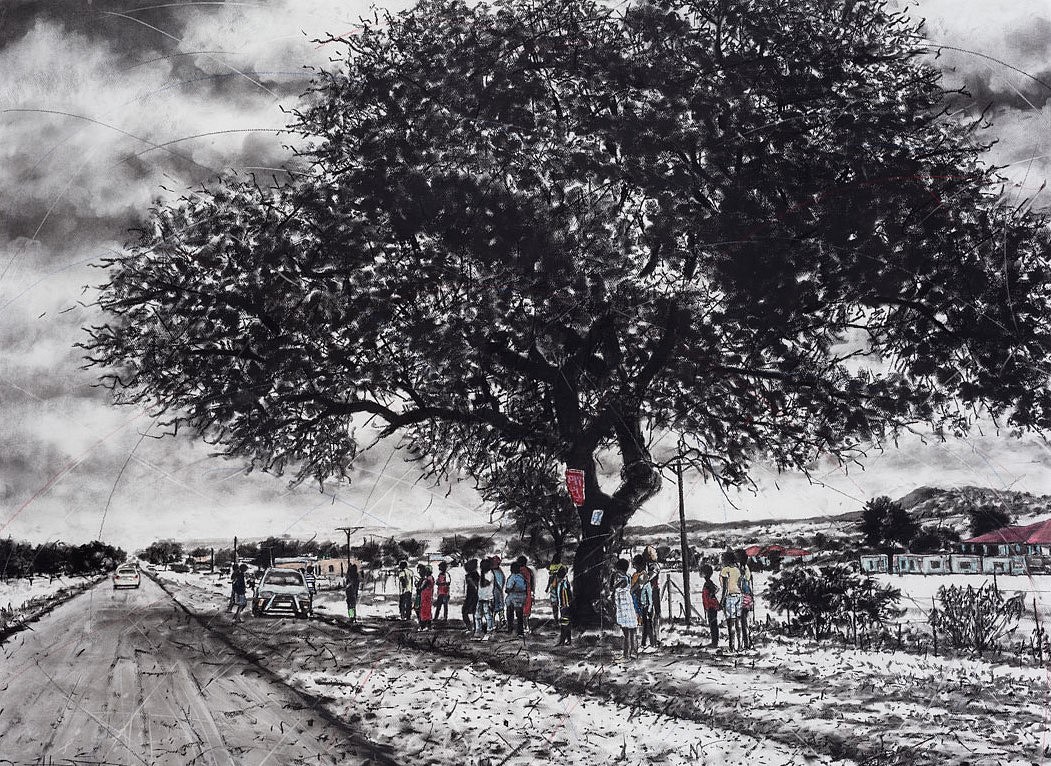PRESS RELEASE

PHILLEMON HLUNGWANI - Mitsheketo yale makaya (stories from a place I call home)
Oct 3 – Nov 2, 2024
Phillemon Hlungwani’s latest body of work has cinematic qualities. Equally, spending an hour or two with the acclaimed artist is like having a one-on-one walkthrough with a film’s director.
“Now this”, the consummate raconteur says motioning towards a piece titled, kurhula a kuve na n’wina - “can’t you just imagine walking with these women to church?” And just like that you’re in the moment. It’s a Sunday morning and there’s a faint chill in the air as the Limpopo sun starts to cast its rays over the long stretch of veld and patches of trees and shrubs in the distance.
Then we cut to loko hi khomana hi nga endla ku hambana emugangeni. “Can you see the crowd’s excitement – with their hands in the air and smiles on their faces?” Hlungwani asks. It’s true, this swell of humans, in their bright burst of t-shirts and shorts, are headed somewhere and you get the feeling you want to follow them to find out more.
With his trademark charcoal and pastel, Hlungwani has brought an entire world, and more specifically, a particular community to life. There are children playing hekeleheke- hekee! (or as the English call it, ‘Ring a Ring o' Roses’), there are women collecting water and youngsters on their way to a soccer game.
The frozen glimpses vibrate with colour, pattern and humanity. There is always something new to see in these sensitively structured compositions. “Your eye must travel”, Hlungwani says of the way the marks and figures draw your gaze across the image.
It’s a logical jump to assume that most of these vital scenes take their inspiration from his birthplace of Thomo in Giyani. Hlungwani still splits his time between Johannesburg and the Limpopo village and rural life is still pivotal to his existence and art.
Ultimately, Mitsheketo yale makaya is commentary on home, people, and a community. Over umpteen pieces of paper the artist engages with a host of topics ranging from the role of women – and particularly mothers - to how critical encouragement and enrichment are for children and the traditional importance that trees play as a meeting place in the absence of built spaces.
Many of the pieces also speak to Hlungwani’s experience directly. In fact, in creating them he has imagined himself as central to the narrative too.
“The IziNduna are sitting in the sun, listening to a man – that’s me. He’s found success through his art and is talking about how that has changed the community”, he explains. It’s not an exaggeration when you consider that Hlungwani funds various projects in the area – including school art for the local community. But he’s candid about the way his career has been received. “There’s always that 2% of people who either don’t understand how art can be an actual, prosperous job or, are a bit resentful that I’ve done well”, he says. His chosen path should come as no surprise though. Hlungwani grew up in a creative household where his artistic gifts were fiercely fostered by his mother – but he’s at pain to add, “I didn’t choose to be an artist. It chose me”.
Beyond touching on some of the hardships of community life, and the pitfalls of his own success, Hlungwani sees this body of work and its message as overwhelmingly positive. Without missing a beat, he says, “art is where I get my happiness. I can’t wait to touch the charcoal, to see the paper”.
Sarah Buitendach
For enquiries please contact gallery@everard.co.za



